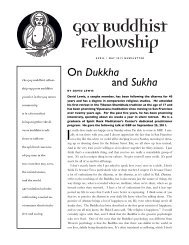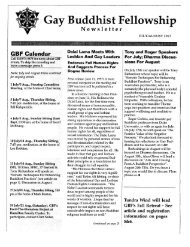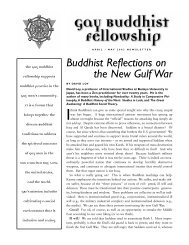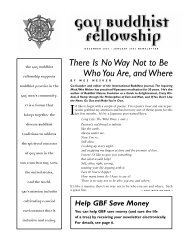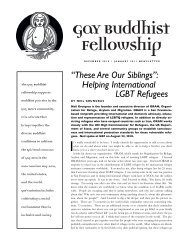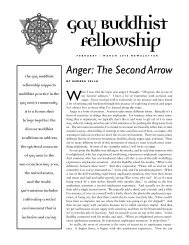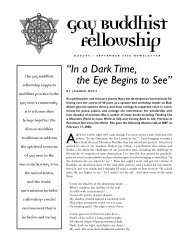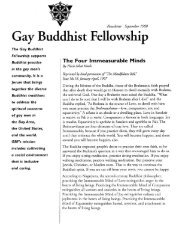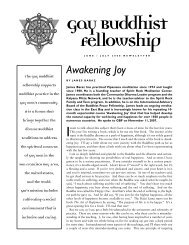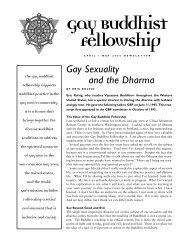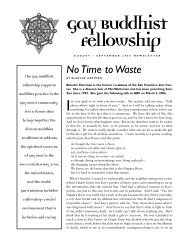2003.06 Jim Wilson (Gratitude Forgiveness and Bodhicitta).pdf
2003.06 Jim Wilson (Gratitude Forgiveness and Bodhicitta).pdf
2003.06 Jim Wilson (Gratitude Forgiveness and Bodhicitta).pdf
Create successful ePaper yourself
Turn your PDF publications into a flip-book with our unique Google optimized e-Paper software.
Gay Buddhist<br />
Fellowship<br />
J U N E / J U L Y 2 0 0 3 N E W S L E T T E R<br />
The Gay Buddhist<br />
Fellowship supports<br />
Buddhist practice in the<br />
Gay men’s community.<br />
It is a forum that<br />
brings together the<br />
diverse Buddhist<br />
traditions to address<br />
the spiritual concerns<br />
of Gay men in the<br />
San Francisco Bay Area,<br />
the United States,<br />
<strong>and</strong> the world.<br />
GBF’s mission includes<br />
cultivating a social<br />
environment that is<br />
inclusive <strong>and</strong> caring.<br />
<strong>Gratitude</strong>,<br />
<strong>Forgiveness</strong>,<br />
<strong>and</strong> <strong>Bodhicitta</strong><br />
BY JIM WILSON<br />
<strong>Jim</strong> <strong>Wilson</strong>, the former abbot of the Chogya Zen Center in New York, has<br />
studied in the Chogye, Fuke, <strong>and</strong> Soto traditions of Zen. In addition to<br />
speaking at GBF on the first Sunday of each month, he leads one weekly<br />
sutra salon in Sebastopol. He gave this talk to GBF on May 4, 2003.<br />
From the perspective of the Buddhist path of purification, anger is something<br />
that needs to be eliminated from one’s mindset. It is possible to do<br />
that through the practices that have been developed within that context.<br />
From the perspective of the path of transformation, how do you use anger for<br />
the benefit of other sentient beings? It’s not as difficult as it may sound. Imagine<br />
you’re taking care of child <strong>and</strong> he runs into the street <strong>and</strong> you tell him not<br />
to. You go through this six times, <strong>and</strong> the sixth time you get angry <strong>and</strong> send the<br />
child to his room, saying, “I really mean it, <strong>and</strong> this is the consequence you’re<br />
going to have to go through if you do that.” This is an expression of concern<br />
for the child. It’s not egoic. It might be a little egoic—there’s a mixture—but<br />
primarily it’s non-egoic: it’s anger growing out of concern for the welfare of a<br />
sentient being. It’s possible for anger to be an expression of compassion. When<br />
that energy appears, how do you transform it so that it is an expression of<br />
enlightened activity? You do so through internalizing <strong>and</strong> contemplating the<br />
bodhisattva vows. The name for this is bodhicitta: the transformation of our<br />
practice so that it’s for the benefit of all sentient beings. When bodhicitta arises<br />
in one’s consciousness, practice becomes very smooth, alive, easy to enter<br />
into. When bodhicitta is not present, it gets a little sticky because it becomes<br />
like a personal possession; possessiveness becomes an aspect of it: “it’s my practice;<br />
it’s my dharma.” <strong>Bodhicitta</strong> dissolves that sense of possessiveness by transforming<br />
practice into the way of saving all sentient beings from suffering.<br />
The text I’m going to use as a basis for talking about bodhicitta is called the<br />
37 Practices of the Bodhisattva, a Tibetan Buddhist text, but I don’t consider it<br />
as a solely Vajrayana work. It feels to me when I read it that it is a work for all<br />
the Buddhist traditions. I was reading the middle length discourses <strong>and</strong> there’s<br />
one where a disciple of the Buddha goes on at length about how wonderful it is<br />
that the Buddha was here for the welfare of all beings, for the welfare of deities<br />
<strong>and</strong> humans, for the benefit of all living creatures. It has a very Mahayana feel<br />
to it. This is the Pali canon. You won’t find the word bodhicitta in the Pali<br />
canon, but you have to go past the word <strong>and</strong> look for meaning. For example,
in the Pali canon the word bodhisattva simply means the<br />
Buddha in a previous life, as he was striving to become a<br />
fully enlightened Buddha. In the Sarvastivada lineages or<br />
in the Sanskrit-based lineages, the word bodhisattva takes<br />
on a very different meaning. So you have to get past that<br />
meaning when you’re reading various works.<br />
So the 37 Practices of the Bodhisattvas contains about<br />
40 verses, including some introductory verses <strong>and</strong> some<br />
concluding verses, <strong>and</strong> each verse is four lines. It’s a very<br />
beautiful text, <strong>and</strong> it’s all about bodhicitta: the turning of<br />
one’s consciousness so that one’s practice is transformed<br />
into a path of liberation for all sentient beings. When we<br />
first come to practice, most of us—this was certainly true<br />
for me—are concerned with our own distress; we enter<br />
into a spiritual practice because we’re in some kind of psychological/spiritual<br />
distress or pain <strong>and</strong> suffering. Sometimes<br />
the pain <strong>and</strong> suffering is from outside. When we<br />
experience great tragedy in our lives, for example, we<br />
might be propelled to do a spiritual practice. So we go to<br />
a meditation center, Buddhist center—or it might be<br />
Hindu, yoga, whatever it is<br />
—in order to get some sense<br />
of peace or centeredness in<br />
the midst of our lives which<br />
seem to be out of control or<br />
unrelentingly filled with suffering.<br />
We want some guidance,<br />
some method, to settle<br />
that. That’s a wonderful<br />
reason to go into spiritual<br />
practice. It’s important to<br />
underst<strong>and</strong> that I’m not saying<br />
that’s wrong, or that that’s a bad motivation. But it’s<br />
kind of like going to a doctor: you take the medicine, <strong>and</strong><br />
then when you get well, you don’t go back to the doctor;<br />
you just go on with your life. People whose focus on spiritual<br />
practice is like that tend to drop out when whatever<br />
was causing the distress passes; they’ve done the meditation,<br />
they’ve done the practices, it’s worked, <strong>and</strong> they<br />
move on. Once again, that’s not bad; it’s good that there<br />
are places people can go in order to gain release from that<br />
kind of distress.<br />
<strong>Bodhicitta</strong> is the arising in one’s consciousness that the<br />
reason for entering practice is to benefit others. When that<br />
appears, there’s a motivation to continue one’s path.<br />
That’s why bodhicitta is considered so important, so pivotal.<br />
If at some point that doesn’t arise, then the practice<br />
will become dull or you will have other things to do, like<br />
go to a movie, or something like that, but when bodhicitta<br />
appears, then you’ll think, "Now I get it; now I know<br />
why I’m doing this or why I should continue doing this."<br />
That’s the function it carries.<br />
And that shift is the first appearance in one’s mind of the<br />
way of the bodhisattva. There’s a work in the Pali canon<br />
called Buddhavamsa, which means chronicle of the Buddhas.<br />
It begins “14 million incalculable eons ago…”—<br />
quite a stenographer! When the Buddha Dipankara was<br />
teaching in a world system incredibly far from where we are<br />
When you experience gratitude<br />
<strong>and</strong> other forms of heart wisdom<br />
such as compassion, love, <strong>and</strong> sympathy,<br />
you’re experiencing the core<br />
underst<strong>and</strong>ing of the Buddha, which<br />
he called dependent origination.<br />
now, there was a young man named Sumedha who studied<br />
under Dipankara. Dipankara means light-bearer or lightbringer.<br />
What arose in Sumedha’s consciousness was that<br />
he wanted to practice <strong>and</strong> follow the way of Dipankara for<br />
the benefit of all sentient beings. And that was the moment<br />
of the appearance of bodhicitta in the consciousness of the<br />
person who would eventually become Shakyamuni Buddha.<br />
So the Chronicle of the Buddhas is the history of all<br />
the buddhas that Shakyamuni studied under in his cosmic<br />
career that eventually resulted in him becoming Shakyamuni.<br />
Whether you believe in this literally or not is not important.<br />
It’s significant that this is a Theravada work, but it is<br />
a perfect illustration of the importance of bodhicitta. That<br />
was the moment, the causal reason, that Shakyamuni<br />
became a buddha. It took fourteen million incalculable<br />
eons, but, hey, he had time. Once again, the Buddhavamsa<br />
doesn’t use the word bodhicitta, but that is a perfect story<br />
or example of the meaning of bodhicitta.<br />
The first verse of the 37 Practices of the Bodhisattva says,<br />
“I pay constant homage through my three doors to my<br />
supreme teacher <strong>and</strong> protector,<br />
Chen Rezig, who while<br />
seeing all phenomenon lack<br />
coming <strong>and</strong> going makes<br />
single-minded effort for the<br />
good of all living beings.”<br />
(The three doors are body,<br />
breath <strong>and</strong> mind.) I find it<br />
very significant that it<br />
begins with an homage,<br />
because an homage is an<br />
expression of gratitude.<br />
You pay homage to that which you feel grateful for, not to<br />
that which you are repulsed by. And gratitude is the key,<br />
the golden door, to the cultivation of bodhicitta. In a way,<br />
you could say that the first practice of the Bodhisattva is<br />
gratitude. Why do I say gratitude is the golden door <strong>and</strong><br />
key? Because it is an expression of heart wisdom. By heart<br />
wisdom I mean the awareness of the interconnectedness of<br />
all things. That awareness is the basis from which bodhicitta<br />
can arise. When you feel grateful for something, you<br />
feel connected, <strong>and</strong> there’s a relationship between you <strong>and</strong><br />
that something for which you feel grateful. Without gratitude,<br />
there is the sense of existing as an isolated being.<br />
That’s why gratitude is the golden door.<br />
It’s important to identify in your own consciousness what<br />
it means to be a Bodhisattva. That can be difficult because<br />
in a sense Buddhist texts are not very helpful about this.<br />
One of the Mahayana sutras says, “Celestial flowers are<br />
raining down <strong>and</strong> beams of light from the third eye are illuminating<br />
incalculable realms in the Eastern Quarter.” Well,<br />
I’m not doing any of that. When I’m giving a talk to you,<br />
celestial flowers ain’t coming down. I wouldn’t mind! But<br />
is that what I have to do to be a bodhisattva? To be a bodhisattva,<br />
do I have to ascend into the sky <strong>and</strong> do all these<br />
miraculous deeds? All of those wonderful images can serve<br />
to inspire, but on the other h<strong>and</strong> they can serve to discourage<br />
us, because I’m just an ordinary human here <strong>and</strong> the<br />
2 GBF JUNE / JULY 2003 NEWSLETTER
gaps are so great. But if you begin with the underst<strong>and</strong>ing<br />
of gratitude as the basic expression of the bodhisattva, then<br />
that’s what being a bodhisattva means. It means being<br />
grateful for all sentient beings without exception. When<br />
you feel grateful for something, you spontaneously want to<br />
do something for that which you feel grateful for. That’s<br />
why the bodhisattva activity is not strained; it’s not a duty<br />
or a compulsion. If you begin to underst<strong>and</strong> <strong>and</strong> appreciate<br />
all that has been given to us, instead of all that has been<br />
done to us, then you begin to think, “Oh! I will give back<br />
to existence some of what has been given to me.” The cultivation<br />
of gratitude is really the key, <strong>and</strong> you can recognize<br />
that it spontaneously appears in your own consciousness<br />
when you feel grateful for someone, or a book, a movie, a<br />
garden; that consciousness is what it means to be a bodhisattva.<br />
Even if it’s momentary, even if it fades, it’s important<br />
to recognize that consciousness: “Oh, that’s what<br />
being a bodhisattva is like.” It means activity based on that<br />
sense of awareness.<br />
What I’m getting at in terms of heart wisdom <strong>and</strong> gratitude<br />
is that when you experience<br />
gratitude <strong>and</strong> other forms of<br />
heart wisdom such as compassion,<br />
love, <strong>and</strong> sympathy, you’re<br />
experiencing the core underst<strong>and</strong>ing<br />
of the Buddha, which<br />
he called dependent origination,<br />
<strong>and</strong> which I like to call interdependent<br />
transformation. That<br />
teaching is pivotal. It is the intellectual<br />
expression of the reality<br />
that one experiences when one is<br />
in a state of gratitude. So, the<br />
intellectual expression is to clarify that there’s no such thing<br />
as a separately existing entity of any kind. Well, that’s complicated.<br />
It means that when you are experiencing gratitude,<br />
that’s the reality of your existence. Your actual condition<br />
is that you are connected to everything, <strong>and</strong> you can<br />
underst<strong>and</strong> why the Buddha felt that way when you experience<br />
gratitude. It’s not just a neat idea. It’s also a neat<br />
experience. So gratitude is the bridge from the cultivation<br />
of what are called the four immeasurables to the full blossoming<br />
of bodhicitta, which is practicing for the benefit of<br />
all sentient beings. The four immeasurables are love, compassion,<br />
sympathy <strong>and</strong> equanimity. They are called the<br />
immeasurables because they’re considered qualities of consciousness<br />
that are limitless in their true nature. They’re<br />
also called brahmaviharas, which means the homes of the<br />
gods. The idea is that the cultivation of these forms of<br />
awareness will take you to a celestial realm. Think of it<br />
metaphorically: when you are experiencing love—think of<br />
new love—the world is wonderful; everything is wonderful:<br />
it’s that sense of being in a celestial domain, when you’re<br />
completely experiencing that.<br />
There are three levels of heart wisdom. One level is the<br />
spontaneous arising of that sense of connectedness. <strong>Gratitude</strong><br />
spontaneously arises, <strong>and</strong> love spontaneously arises.<br />
Within the Buddhist context, love means wanting others to<br />
As long as there is something<br />
in one’s consciousness that<br />
one cannot forgive, then<br />
there’s a limitation, <strong>and</strong> the<br />
complete expansiveness of<br />
the bodhisattva mind <strong>and</strong><br />
heart is not available.<br />
be well <strong>and</strong> happy. Compassion spontaneously arises<br />
when you want others to be free from suffering. Sympathetic<br />
joy arises when you are happy at other people’s success,<br />
<strong>and</strong> equanimity in this context when spontaneously<br />
you wish others to have peace of mind <strong>and</strong> serenity of<br />
heart. All of those arise spontaneously in our consciousness.<br />
The function of a Buddhist teacher in this context is<br />
to get you to recognize those spontaneous experiences as<br />
more important than just a mood. They’re not a passing<br />
mood; they are your true nature. So that recognition is<br />
key, <strong>and</strong> then follows cultivation. The system of the four<br />
immeasurables is to cultivate that awareness so that it<br />
becomes stabilized <strong>and</strong> a constant presence in one’s mind<br />
<strong>and</strong> heart.<br />
Still, that awareness isn’t necessarily experienced for the<br />
benefit of all sentient beings. How do you bridge, go from<br />
the four immeasurables to the four or five bodhisattva<br />
vows? You do that through the practice of gratitude <strong>and</strong><br />
forgiveness. <strong>Gratitude</strong> is the most important of the two<br />
because if you feel grateful for someone, even an enemy,<br />
then forgiveness spontaneously<br />
arises. As long as there is some<br />
person or some thing in existence—my<br />
big foible is poison<br />
oak: I always feel that Mother<br />
Nature could have done a better<br />
job in that ecological niche, <strong>and</strong><br />
I have endless resentments<br />
against poison oak, so I have to<br />
work on that—as long as there<br />
is something in one’s consciousness<br />
that one cannot forgive,<br />
then there’s a limitation, <strong>and</strong> the<br />
complete expansiveness of the bodhisattva mind <strong>and</strong> heart<br />
is not available. So the way you move from the practice of<br />
the four immeasurables to the full flowering of bodhicitta<br />
is through the cultivation of gratitude <strong>and</strong> forgiveness.<br />
That’s why forgiveness rituals are so prominent in Buddhist<br />
practice, <strong>and</strong> also the cultivation of gratitude.<br />
When you cultivate immeasurable love <strong>and</strong> immeasurable<br />
compassion, there can still be certain constrictions on<br />
that. One of the things that happen when people practice<br />
the four immeasurables is that they run into those constrictions.<br />
I’ll give a concrete example, beyond poison oak.<br />
I had a student who had a list of four people for whom she<br />
would not feel compassion <strong>and</strong> love: everyone else, but<br />
not those four. And she had really good reasons. So these<br />
constrictions can be overt, like a list of people I’m going to<br />
exempt, or it can be very subtle. The way to overcome<br />
those kinds of limitations when practicing the four immeasurables<br />
is by adding in the practice of gratitude <strong>and</strong> forgiveness.<br />
I’m not necessarily saying they have to be done<br />
in sequence; that was just a way of presenting them. <strong>Gratitude</strong><br />
<strong>and</strong> forgiveness feed into the practice of the four<br />
immeasurables, <strong>and</strong> the four inmmeasurables feed into the<br />
practice of gratitude <strong>and</strong> forgiveness, <strong>and</strong> when those<br />
become merged, then one can step into bodhisattva activity<br />
in heart <strong>and</strong> mind.<br />
■<br />
GBF JUNE / JULY 2003 NEWSLETTER 3
ASK DHARMA DADDY<br />
BY ROGER CORLESS<br />
Dharma Daddy Explains<br />
Beardless Youths <strong>and</strong> Maitreya<br />
Dharma Daddy took a rest last issue to free up space<br />
for important reflections on Buddhism <strong>and</strong> the war. In<br />
this issue, he’s back to answer questions from two<br />
readers.<br />
First of all, Kenny writes from Ione, California, in response<br />
to the article “Sex for Queer Buddhists,” to request more<br />
information about the goings on of the Desert Fathers with<br />
the “beardless youths,” <strong>and</strong> to ask about dromba, a word<br />
—meaning passive homosexual partner—that he found in<br />
a review of an autobiography of a Tibetan.<br />
Well, sorry, Kenny, but Dharma Daddy doesn’t know of<br />
any really good dirt on the Desert Fathers <strong>and</strong> beardless<br />
youths. It’s just something that is mentioned in passing as a<br />
danger. Beardless youths are referred to along with women<br />
because, in the culture of the time, they were more or less<br />
equal as sex objects. An older free man (i.e., not a slave)<br />
could have sex, as the active, or penetrating, partner, with a<br />
woman, a slave of either sex, or a boy. When the boy<br />
became an adult, signified by the growth of a beard, he was<br />
off limits. If a free man had sex with another free man, or if<br />
a free man allowed himself to be penetrated by a man (free<br />
man or slave) or by a boy, he was ridiculed as a pervert. Very<br />
similar customs are found in ancient India, medieval Japan,<br />
<strong>and</strong> some parts of the pre-modern Muslim world. In those<br />
cultures, a man could be a mentor to a youth, <strong>and</strong> they<br />
could have sex as long as the boy was a surrogate female,<br />
but when the youth became a man the sexual relationship<br />
was supposed to end. In medieval Japan, becoming a man<br />
was signaled by a special way of cutting the hair so as to<br />
expose part of the scalp, <strong>and</strong> there are reports of youths<br />
adopting that haircut a little early in an attempt to put an<br />
end to the unwanted attentions of an older man.<br />
As for dromba, Dharma Daddy had not heard of the<br />
word, so he wrote to a colleague about it. Officially there<br />
should be no such person in a monastery since monks are<br />
vowed to celibacy, but some monasteries are less strict than<br />
others. In this case, Tashi Tsering, a member of the Dalai<br />
Lama’s sacred dance troupe, willingly became the sexual<br />
partner of a high-ranking monk. Tashi was not a monk,<br />
<strong>and</strong> therefore he was not himself under a vow of celibacy,<br />
<strong>and</strong> he says he isn’t gay, but the relationship was a way for<br />
him to improve his social <strong>and</strong> economic st<strong>and</strong>ing. The<br />
account, says DD’s colleague, “is very interesting <strong>and</strong><br />
somewhat moving.” For the whole story, see The Struggle<br />
for Modern Tibet: The Autobiography of Tashi Tsering by<br />
William Siebenschuh, Tashi Tsering, <strong>and</strong> Melvyn Goldstein<br />
(Armonk NY: M. E. Sharpe, 2000).<br />
Tashi <strong>and</strong> the monk seem to have had “real” sex. Another<br />
of Dharma Daddy’s colleagues reports that some monks<br />
will engage in a form of frottage in which one partner grips<br />
the penis of the other between his thighs. Since the authoritative<br />
texts forbid the use of the mouth, anus, or h<strong>and</strong> for<br />
sex, this procedure can be regarded as “not sex.” (Does this<br />
remind us of the remarks of a former President of the USA?)<br />
Some abbots turn a blind eye to this strategy, but the Dalai<br />
Lama, reportedly, does not sanction it.<br />
The second enquiry comes from Michael in San Francisco,<br />
California, who attended a peace rally at which<br />
some people were holding signs proclaiming “Maitreya is<br />
here!” The literature they passed out, he says, referred<br />
to a Scotsman named Benjamin Creme, who had been<br />
channeling higher powers since 1974 to prepare the<br />
world for the arrival of Maitreya, a sort of messiah Buddha<br />
who is said to have made a brief appearance in<br />
Nairobi, where his audience, predominantly Christian,<br />
mistook him for Jesus. Michael asks if Buddhism anticipates<br />
a messianic Buddha who will come to solve the<br />
world’s problems <strong>and</strong> if we should take Benjamin Creme<br />
seriously or not.<br />
Strange as it may seem, it’s not so strange. Every Buddhist<br />
tradition identifies Shakyamuni not as “the” Buddha<br />
but merely the Buddha for our times, the most recent Buddha,<br />
<strong>and</strong> both the Mahayana <strong>and</strong> the Theravada say the<br />
next Buddha is to be called Maitreya. He is no minor figure.<br />
There is an extensive literature on him, which Jan<br />
Nattier, in a collection of essays about Maitreya<br />
(Maitreya, the Future Buddha, edited by Alan Sponberg<br />
<strong>and</strong> Helen Hardacre. Princeton University Press, 1988),<br />
has suggested can be grouped into four major categories<br />
or types of manifestation: (i) here/now (we will meet<br />
Maitreya on earth during our lifetime); (ii) here/later (we<br />
will meet him on earth in a future rebirth); (iii) there/now<br />
(he is living in the realm of the Tushita deities <strong>and</strong> we can<br />
meet him in meditation); (iv) there/later (we will meet him<br />
when we are reborn in the Tushita realm).<br />
Dharma Daddy’s library has a copy of a booklet by Benjamin<br />
Creme called Messages from Maitreya, The Christ,<br />
1–10.. It is undated, but he has a note that he picked it up<br />
at an occult bookshop in London in 1979. The introduction<br />
says, “The long-awaited <strong>and</strong> hoped—for reappearance<br />
of the Christ is now an accomplished fact. On July<br />
19th 1977, the Christ, Maitreya, the World Teacher, Head<br />
of our Spiritual Hierarchy, emerged from His ancient<br />
retreat <strong>and</strong> is now in the modern world.” The messages in<br />
the booklet were not channeled, we are told, but “the<br />
method used is mental overshadowing <strong>and</strong> the telepathic<br />
rapport which is thus set up.” Then, on 11 June, 1988,<br />
4 GBF JUNE / JULY 2003 NEWSLETTER
Maitreya made a physical appearance in Nairobi. Creme’s<br />
Maitreya might be understood as Nattier’s type (iii) leading<br />
into type (i). The web site of Creme’s organization,<br />
Share International, identifies Maitreya with “Christ, Messiah,<br />
the fifth Buddha, Krishna, <strong>and</strong> the Imam Mahdi.”<br />
This list is unusual, not to say perplexing, since Hindus<br />
generally expect Kalkin, not Krishna, to come at the end of<br />
the world. The Mahdi as the reappearance of the Hidden<br />
Imam is a Muslim figure, but he is only recognized in the<br />
Shi‘a branch of Islam. Maitreya is called “the Buddhist<br />
Messiah” in popular textbooks, but a careful analysis of<br />
the traditions about him shows that he does not bring in<br />
the new age (as the Messiah may) but appears as the next<br />
Buddha to confirm the new age after it has arrived.<br />
Creme’s “here/now” Maitreya has some competition.<br />
H. H. Gyalwa Jampa, a white American in his early fifties,<br />
is identified as Buddha Maitreya, Jesus Christ, Gautama<br />
Buddha, the Avatar Archangel Michael/Metatron, the<br />
Lord of Shambhala Sanat Kumara, Melchizedek, <strong>and</strong> the<br />
Ancient of Days. Following<br />
a minority tradition,<br />
Maitreya is here<br />
called a Buddha rather<br />
than a Bodhisattva.<br />
Amongst other activities,<br />
H. H. Buddha<br />
Maitreya imparts<br />
“metatronic healings”<br />
by (guess what?) “telepathic<br />
overshadowing.”<br />
Based on Mount<br />
Shasta, his centers<br />
include an Archangel<br />
Michael’s Soul Therapy<br />
Center in Berkeley.<br />
Dharma Daddy visited the Berkeley center <strong>and</strong>, under the<br />
instruction of a fellow Brit called Lama Jake, he meditated<br />
under a sort of open tent made of metal rods while<br />
alternately holding an instrument resembling the traditional<br />
Tibetan dorje (thunderbolt), but much larger <strong>and</strong><br />
made of wire <strong>and</strong> crystals, <strong>and</strong> a crystal on a thread called<br />
an etheric weaver, to the sounds of H. H. Buddha<br />
Maitreya chanting on a CD. He found it calming <strong>and</strong> curiously<br />
energizing, <strong>and</strong> awoke the next day unexpectedly<br />
horny, whether as a result of the metatronics or not he<br />
does not know. (www.buddhamaitreya.org or 877-444-<br />
7685 for more information)<br />
The best-known form of Maitreya is the so-called<br />
Laughing Buddha, a familiar figure in gift shops. Fat,<br />
disheveled, <strong>and</strong> often surrounded by children, he carries<br />
the hempen sack from which he gets his name (Chinese:<br />
Budai; Japanese: Hotei). He was a sort of hippie monk in<br />
tenth century China who w<strong>and</strong>ered about, smiling <strong>and</strong><br />
muttering to himself, <strong>and</strong> collecting junk which he put in<br />
his sack <strong>and</strong> gave away to children, who delighted in “the<br />
sack of wonderful things.” Because he was always happy<br />
he was thought to be Maitreya (the name literally means<br />
“The Friendly One”), <strong>and</strong> he is popularly regarded as a<br />
Every Buddhist tradition identifies<br />
Shakyamuni not as “the” Buddha<br />
but merely the Buddha for our<br />
times, the most recent Buddha,<br />
<strong>and</strong> both the Mahayana <strong>and</strong> the<br />
Theravada say the next Buddha is<br />
to be called Maitreya.<br />
deity of good luck <strong>and</strong> a protector of children.<br />
Less well known in the west, <strong>and</strong> much less fun, certain<br />
kings <strong>and</strong> revolutionaries in Southeast Asia have at<br />
one time or another been identified as Metteyya (the Pali<br />
form of Maitreya).<br />
An example of Nattier’s type (ii), "here/later," is the<br />
Maitreya Project (www.maitreya-statue.org). The Foundation<br />
for the Preservation of the Mahayana Trust<br />
(FPMT), which runs Vajrapani, where GBF holds retreats,<br />
is raising funds to build a 500 foot tall statue of Maitreya<br />
as part of a temple <strong>and</strong> library in Bodh Gaya, India, near<br />
the site of Buddha Shakyamuni’s enlightenment. If completed,<br />
this will be “the largest Buddhist statue in the<br />
world” <strong>and</strong> will bring “peace <strong>and</strong> happiness to the<br />
world.” (Why do Buddhists have such big statues when<br />
they believe in Emptiness? That’s another question, if<br />
someone would like to ask it.)<br />
A more typical example of type (ii) is the annual<br />
Maitreya festival at the monastery established by Geshe<br />
Wangyal in Washington,<br />
New Jersey. During<br />
the ceremony a<br />
very large thangka<br />
(painting) of Maitreya<br />
is brought out <strong>and</strong><br />
prayers are said for<br />
those in attendance to<br />
be reborn during the<br />
time when Maitreya<br />
will appear.<br />
A famous case of<br />
type (iii), channeling<br />
Maitreya in<br />
“there/now” mode, is<br />
recounted in the life<br />
of the Bodhisattva Asanga. He had searched long <strong>and</strong><br />
hard for a teacher, without success, when he came across<br />
an injured dog with maggots crawling in its wounds.<br />
Wishing to help the dog but not harm the maggots (since<br />
they also were sentient beings), he bent down to lick the<br />
maggots off the dog with his tongue. He was so repulsed<br />
by this that he shut his eyes, but then he felt a change,<br />
opened his eyes, <strong>and</strong> found that the dog had disappeared<br />
<strong>and</strong> been replaced by Maitreya, who praised him for his<br />
compassion <strong>and</strong> gave him a teaching which became the<br />
first of many texts which laid the foundation of the<br />
Yogachara school.<br />
So, in summary, reports of Maitreya being active in the<br />
world are not unusual. You can decide for yourself<br />
whether the messages transmitted through Benjamin<br />
Creme should be taken seriously or not by going to hear<br />
him. He has speaking engagements in the USA in July <strong>and</strong><br />
August 2003 <strong>and</strong> will be in San Rafael, California, on<br />
August 3 (www.share-international.org or 888-877-8272<br />
for more information).<br />
■<br />
Send questions for Dharma Daddy to GBF<br />
or by e-mail to: tashi5@juno.com<br />
GBF JUNE / JULY 2003 NEWSLETTER 5
GBF<br />
STEERING COMMITTEE<br />
Michael Gabel<br />
David Holmes<br />
Michael Langdon<br />
Lee Robbins<br />
Paul Shepard<br />
TREASURER<br />
Teng-How Bae<br />
NEWSLETTER<br />
Editor<br />
Michael Langdon<br />
Contributing Editor<br />
Roger Corless<br />
Design / Layout<br />
Michael Gabel<br />
Mailing List<br />
Robin Levitt<br />
Newsletter Mailing Party<br />
Jack Busby<br />
Transcriber<br />
<strong>Jim</strong> Stewart<br />
MAIL<br />
Snake Woolington<br />
HAMILTON HOUSE<br />
Volunteer Coordinator<br />
Clint Seiter<br />
PRISON OUTREACH<br />
Coordinator<br />
Don Weipert<br />
WEBSITE<br />
Webmaster<br />
Joe Kukulka<br />
SUNDAY SITTINGS<br />
Facilitator Coordinator<br />
Paul Shepard<br />
Facilitators<br />
Jack Busby<br />
Howard De Porte<br />
<strong>Jim</strong> Stewart<br />
Bob Seidle-Khan<br />
Host Coordinator<br />
Peter Washburn<br />
Hosts<br />
Paul Albert<br />
Rachmael Ben-Avram<br />
Jack Busby<br />
Francis Gates<br />
Richard Hedden<br />
Greg Hughes<br />
Kai Matsuda<br />
Sound / Recordings<br />
Patrick Burnett<br />
George Hubbard<br />
2003 Fall Retreat<br />
GBF will return to Vajrapani Institute, Boulder Creek, California,<br />
for the popular Fall Retreat, between Friday, September 5 <strong>and</strong> Sunday, September<br />
7 (the weekend after Labor Day). Activities (or should that be nonactivities?)<br />
will include sitting <strong>and</strong> walking meditation, some simple ceremonies,<br />
Dharma talks by <strong>Jim</strong> <strong>Wilson</strong> <strong>and</strong> discussions facilitated by Roger<br />
Corless (a.k.a. Dharma Daddy). The Institute abuts Castle Rock State Park<br />
<strong>and</strong> there will be free time for hiking on the more than 33 miles of trails<br />
amongst the redwoods, or just relaxing. Registration fee includes all meals<br />
<strong>and</strong> dormitory style accommodation. A few private cabins will be available at<br />
extra cost.<br />
Reserve the dates now <strong>and</strong> plan to join your gay brothers in a time of spiritual<br />
renewal. Full details <strong>and</strong> registration forms will be included in the next<br />
newsletter.<br />
Prisoners Urgently Need Buddhist Books<br />
The most frequent request from gay Buddhist prisoners, other<br />
than pen pals, is for books. In many prisons, they are circulated among small<br />
groups <strong>and</strong> are used in daily <strong>and</strong> group practice. All books are welcome, particularly<br />
those suitable for beginners. If you have any available, please call Don<br />
Wiepert at (510) 540-0307, or email him at GDWiepert@aol.com. Don will<br />
arrange to collect them <strong>and</strong> get them to prisoners.<br />
Your Thrift Store<br />
Donations Earn Money for GBF<br />
GBF members can donate their quality cast-offs to the Community<br />
Thrift Store (CTS) <strong>and</strong> GBF will receive a quarterly check based on the volume<br />
of items sold. This is a great way to support our Sangha, <strong>and</strong> the community.<br />
So far this year we have received over $800 through members’ generosity.<br />
Bring your extra clothing <strong>and</strong> other items to CTS at 623 Valencia St between<br />
10am <strong>and</strong> 5pm, any day of the week. The donation door is around the corner<br />
on Sycamore Alley (parallel to <strong>and</strong> between 17th <strong>and</strong> 18th) between Valencia<br />
<strong>and</strong> Mission. Tell the worker you are donating to GBF. Our ID number is 40.<br />
Information: (415) 861-4910.<br />
■<br />
■<br />
■<br />
6 GBF JUNE / JULY 2003 NEWSLETTER
Calendar<br />
San Francisco / Bay Area Events<br />
Sunday Sittings<br />
10:30 am to 12 noon<br />
Every Sunday followed by a talk or discussion, at the San Francisco Buddhist Center,<br />
37 Bartlett Street (near 21st St between Mission <strong>and</strong> Valencia).<br />
MUNI: 14 Mission or 49 Van Ness-Mission, alight at 21st St, walk 1/2 block.<br />
BART: 24th <strong>and</strong> Mission, walk 31/2 blocks. Parking: on street (meters free on Sundays)<br />
or in adjacent New Mission Bartlett Garage (75¢ first hour, then $1 per hour, $5 max).<br />
The Center is h<strong>and</strong>icapped accessible.<br />
June / July GBF Sunday Speakers<br />
June 1 <strong>Jim</strong> <strong>Wilson</strong><br />
<strong>Jim</strong> <strong>Wilson</strong>, the former abbot of the Chogye Zen Center in New York, has studied in<br />
the Chogye, Fuke, <strong>and</strong> Soto traditions of Zen. In addition to speaking at GBF on the<br />
first Sunday of every month, he leads two weekly sutra salons here Sebastopol.<br />
June 8 Diana Elrod<br />
Diana Elrod, an active member of Soka Gakkai International (SGI), will speak about<br />
the Nichiren tradition.<br />
June 15 Open Discussion<br />
Steve Peskind, co-founder of the Coming Home Hospice, the San Francisco Shanti<br />
Project, <strong>and</strong> the Buddhist AIDS Project, has practiced meditation since 1973.<br />
June 22 Roger Corless<br />
Roger Corless is Professor of Religion, Emeritus, at Duke University. Having retired<br />
to the Bay area, he contributes to the GBF Newsletter under the nom de plume<br />
Dharma Daddy. He is the author of several books, including the widely praised Vision<br />
of Buddhism: The Space Under the Tree.<br />
June 29 Justin Hecht<br />
Justin Hecht is a psychologist who practices in San Francisco, specializing in stress<br />
reduction <strong>and</strong> personal growth. He has practiced Vipassana meditation for many years<br />
<strong>and</strong> seeks to integrate his Western psychological training with Buddhist spirituality.<br />
July 6<br />
<strong>Jim</strong> <strong>Wilson</strong><br />
July 13 Bill Weber<br />
Bill Weber is a senior vipassana student who is currently training in the Community<br />
Dharma Leaders program at Spirit Rock Meditation Center. Also a film editor <strong>and</strong><br />
director, Bill co-directed the award-winning documentary The Cockettes.<br />
July 20<br />
Open Discussion<br />
July 27 Losang Monlam<br />
Losang Monlam is a monk <strong>and</strong> spiritual program coordinator for the Tse Chen Ling<br />
Center for Tibetan Buddhist Studies in San Francisco. He will lead us in a traditional<br />
Tibetan Buddhist meditation at 10:30 <strong>and</strong> give a dharma talk at 11:00.<br />
Miss a Dharma Talk?<br />
You can listen to it on the Internet.<br />
Audio files of Dharma talks are available<br />
on the GBF website.<br />
How to Reach Us<br />
For 24-hour information on GBF<br />
activities or to leave a message:<br />
415 / 974-9878<br />
World Wide Web Site<br />
www.gaybuddhist.org<br />
GBF Sangha<br />
Mail correspondence:<br />
GBF<br />
PMB 456<br />
2215-R Market Street<br />
San Francisco, California 94114<br />
For address changes or to subscribe or<br />
unsubscribe to the Newsletter send<br />
email to:<br />
mailinglist@gaybuddhist.org<br />
GBF Newsletter<br />
Send submissions to:<br />
editor@gaybuddhist.org<br />
GBF Yahoo<br />
Discussion Group<br />
There is now a GBF discussion group<br />
for the general membership (<strong>and</strong> others)<br />
on Yahoo.<br />
Join the discussion at:<br />
www.groups.yahoo.com/group/gay<br />
buddhistfellowship<br />
Steering<br />
Committee Meeting<br />
The next Steering Committee<br />
Meeting will be July 7, 2002,<br />
following the Sunday sitting, at<br />
the San Francisco Buddhist Center.<br />
Volunteers Needed<br />
Volunteer host needed one Sunday<br />
per month. Contact Peter at (510)<br />
531-7131 or petersfo@aol.com<br />
Other positions: We also need volunteers<br />
to organize potlucks, to help<br />
record dharma talks, to publicize the<br />
sangha, <strong>and</strong> to serve on a practice committee.<br />
If you’re interested in helping<br />
out, please send an email to volunteers@gaybuddhist.org,<br />
or you can<br />
volunteer in person by approaching any<br />
steering committee members at one of<br />
the Sunday sittings.<br />
GBF JUNE / JULY 2003 NEWSLETTER 7
GBF NEWSLETTER<br />
PMB 456<br />
2215-R MARKET STREET<br />
SAN FRANCISCO CA 94114<br />
ADDRESS SERVICE REQUESTED<br />
By the power <strong>and</strong> truth of this practice, may all beings have<br />
happiness <strong>and</strong> the causes of happiness, may all be free from sorrow<br />
<strong>and</strong> the causes of sorrow, may all never be separated from the sacred<br />
happiness which is without sorrow, <strong>and</strong> may all live in equanimity,<br />
without too much attachment or too much aversion, <strong>and</strong> live<br />
believing in the equality of all that lives.<br />
—GBF Dedication of Merit



